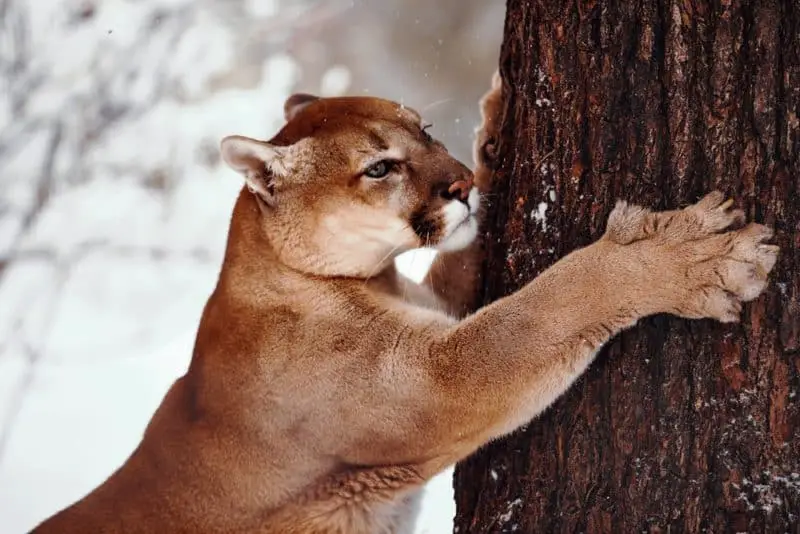The state of Idaho is home to three species of wild cats. these are the mountain lion, the Canadian lynx, and the bobcat.
We’ll talk about each of these three wild cats in the paragraphs below.

Mountain lions in Idaho (Puma concolor)
Due to the fact that they live over a wide geographical area, mountain lions have a long list of regional names. In recent years, their scientific name was even changed from Felis concolor to Puma concolor. Some common names that mountain lions go by are cougar, panther painter, Andean Mountain lion, and puma.
Mountain lions are not only large predators, but they’re also apex predators. However, in areas where they share territory with black bears, brown bears, grizzly bears, and gray wolves, the mountain lion either has to give up some of its kills to these top predators or is actively preyed upon by them.
For example, in Wyoming’s National elk refuge, researchers began to monitor a pack of 5 wolves that moved into the area in 1999. The wolves not only pushed out the mountain lions but also preyed on them. In a 17-year period, wolves reduced the mountain lion population in the area by 48%. See
Where are mountain lions typically found?
Mountain lions live on all three of the American continents. They have the largest range of any land mammal. It begins in Canada’s Yukon territory and extends south through 28 countries in North America, Central America, and South America to the southern tip of Argentina. See
In Canada, the biggest populations of them are in British Columbia and Alberta. On the other hand, in the U.S., they mainly live in the western states, South Dakota and Nebraska in the mid-west, and Florida in the southeast. In Florida, the cougar is called the Florida Panther.
There are around 2,000 mountain lions in Idaho.
What do mountain lions look like?
To visualize what a mountain lion looks like, picture a giant domestic cat with short tan hair. Mountain lions are much larger than domestic cats, though. Average house cats weigh in at around 10 pounds, while male mountain lions can weigh over 200 pounds.
Mountain lions have lean, muscular bodies, rounded heads, and upright ears that are oval at the tip. Another characteristic of the mountain lion is its long, black-tipped tail, which accounts for almost one-third of its entire length. They use their long tail for a counterbalance, moving it from side to side as they navigate through uneven terrain.
Mountain lions have a light brown coat of short, coarse hair over most of their body. The area around their nose, the tip of their tail, and the tips of their ears are black. Their belly, the area above their upper lip, below their lower lip, and their chin are all white. They also have a sprinkling of dark hair on their backs. There are some coat color variances between different geographic locations.
Mountain lions are the fourth largest wild cat in the world. They are smaller in size only than the Jaguar in the western hemisphere. However, worldwide, the African Lion and the Tiger are also larger.
Male and female mountain lions are phenotypically identical in every respect except for size. Males are 30 to 40% bigger than female cougars. Sizes vary considerably throughout the cat’s geographic range.
According to the Idaho Fish and Game, in their state, an adult male cougar typically weighs between 110 and 180 pounds. A rare few of them grow up to 265 pounds. Female mountain lions or queens average between 64 and 140 pounds. Adult males or toms will reach a length of 5 1/2 to 9 feet from their snout to the tip of their tail. On the other hand, adult females are 5 to 7 1/2 feet long.
Large cat but not a big cat
A fun fact is that even though mountain lions are large cats, they are not taxonomically classified as big cats because they cannot roar. Snow leopards, for example, are smaller than mountain lions, but since they can roar and cannot purr, they are classified as big cats, while mountain lions are not. Another interesting thing that I can mention here is that mountain lions purr.
Since they purr and cannot roar, mountain lions are in the Felis genus, while big cats that cannot purr and can roar are in the Panthera genus.
As of the year 2017, mountain lions are taxonomically divided into 2 sub-species. The first is (Puma concolor couguar) or northern cougar. Northern cougars range through North America, Central America, and possibly northwestern South America. The second sub-species is (Puma concolor concolor) or southern cougar. These cats range only in South America.
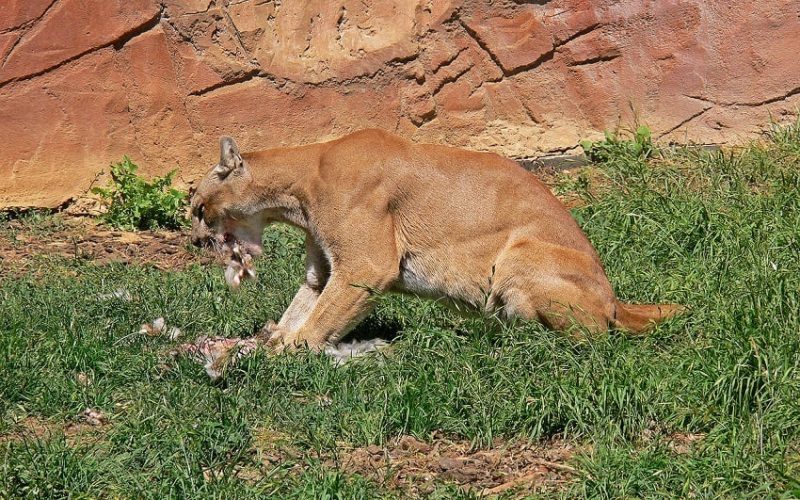
What do mountain lions eat?
Cougar populations are most heavily concentrated in areas where their prey animals are the most heavily concentrated. The cougar’s favorite prey is deer.
On average, an adult mountain lion kills a deer or its equivalent in meat once a week. They also prey on other animals.
Prey availability is also determinant to their prey selection. For example, in a study done within Yellowstone National Park, researchers found that Elk comprised 74% of mountain lion kills. See
In Idaho, mountain lions prey on mule deer, white-tailed deer, elk, moose, Rocky Mountain bighorn sheep, Rocky Mountain goats, pronghorn antelope, wild horses, coyotes, raccoons, rabbits, birds, prairie dogs, pack rats, various small rodents, porcupines, skunks, snakes, pets, feral cats, livestock, and any other native wild animals they can catch.
When mountain lions become habituated to living in close proximity to humans, they’re more likely to prey on livestock and pets. Per a January 2020 article in the Idaho Press, In the winter of 2019/2020, “Four dogs were attacked, and three were killed, and an unknown number of house cats have been preyed upon by mountain lions in the Wood River Valley.” See
Mountain lion behavior
Mountain lions are solitary animals. It’s a Rarity to see 2 or more together unless during mating or in the case of raising young.
They have expansive home territories. In fact, an adult male cougar’s home range is normally more than 100 square miles and up to 250 square miles. They sometimes mark their territory by leaving claw marks on trees. They also scratch up piles of leaves and or pine needles that they urinate on as a scent marker. Male mountain lions fight to the death sometimes to defend their territory.
A mountain lion is a formidably tough wild animal. They can run 40 to 50 miles per hour for short bursts and jump up to 40 feet with a running start. They can also leap 15 feet vertically from a flat-footed start. See
Mountain lion hunting in Idaho
The following quote is from the Idaho Fish and Game website.
“Hunters may pursue mountain lions ten months of the year in Idaho and can buy multiple tags in a single year. Electronic calls can be used in a limited number of hunting units. Nonresident deer and elk tags may also be used to harvest a black bear or mountain lion.” For more information on lion hunting in Idaho, look here.
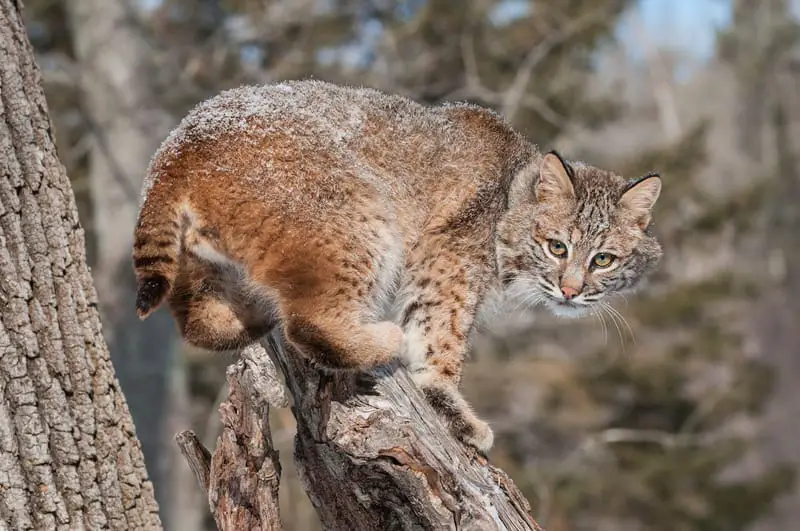
Bobcats in Idaho (Lynx rufus)
The Bobcat, which is also known as the red lynx, is a North American wild cat. They’re actually a type of lynx.
Biologists believe that both the bobcat and the Canada lynx are descendants of the Eurasian lynx whose ancestors crossed into North America via the Bearing Sea land bridge.
Bobcats are the most widely distributed cat in North America. Their range begins in southern Canada and extends south through the United States and down into northern Mexico.
Compared to Canadian lynx, which thrive in deep snow country, bobcats struggle more in the snow due to the fact that they cannot walk on top of it like lynx can. A Canada lynx’s paws are proportionately huge. Consequently, they are able to use them like snowshoes to travel on the snow’s surface. On the other hand, compared to lynxes, bobcats have small feet that tend to sink into the snow. Bobcat tracks are about half as wide as lynx tracks. If the snow is too deep and powdery, it reduces their mobility along with their ability to catch prey. This is why the bobcat range dies out in southern Canada. From there on north, Canada lynx are more prevalent and bobcats, less so.
What do bobcats look like?
Bobcats are small wild cats. They’re Idaho’s smallest wild cat. They are roughly twice the size of a domestic cat. A housecat cat has a longer tail, though.
A bobcat is 2 to 3 feet long and weighs about 15 to 35 pounds. A Female bobcat is quite a bit smaller than a male.
These animals have “bobbed” short tails with black bands on their upper surface. Their tail also has a black tip on its upper surface but not the back. Their fur is usually gray to brown, with mottled dark markings that range from black to dark brown on their bodies. They also have black stripes on their inner forelegs and tail.
From a side view, you will notice that a bobcat is slightly higher at the rump than at the shoulders. Bobcats and lynx have long back legs in proportion to their front legs.
Bobcats have smaller ear tufts than a lynx, but they have black-tufted ears just like a lynx does. In other words, they have tufts of hair that poke up above their ears that are black at the tips. The backs of the ears, below the black tips, are black. In the center of the black of each ear, they have a single white spot. This gives the impression of a false eye on the back of each ear.
They also have a whiskered face that seems broader due to their long ruffled facial hair and whiskers. Their eyes are yellow with round black pupils.

What do bobcats eat?
Despite their comparatively small size, bobcats are aggressive, tough predators. At times, particularly during the winter, they prey on animals that are much larger than they are, such as small deer. However, their regular diets mainly consist of smaller prey such as small mammals, reptiles, and birds such as an occasional wild turkey or pheasant, along with various songbirds, insects, and carrion. When they take up residence close to urban environments, their menu might occasionally also include small pets.
Interestingly, bobcats even prey on venomous snakes, even though they are not immune to their venom. They accomplish this by using their quickness to pin the snake’s head down with a paw, after which they dispatch the snake with a quick bite to its spine behind the head.
The venomous snakes in Idaho are the Great Basin Rattlesnake (Crotalus lutosus), the Northern Pacific Rattlesnake (Crotalus oreganus), and the Prairie Rattlesnake (Crotalus viridis viridis). See
Hunting and trapping bobcats in Idaho
Idaho, bobcats are classified as furbearers. The Idaho bobcat hunting and trapping season runs from December 14th through February 16th. Currently, there are no bag limits. Regulations change through the years, though. Look here for complete information on licensing and regulations.
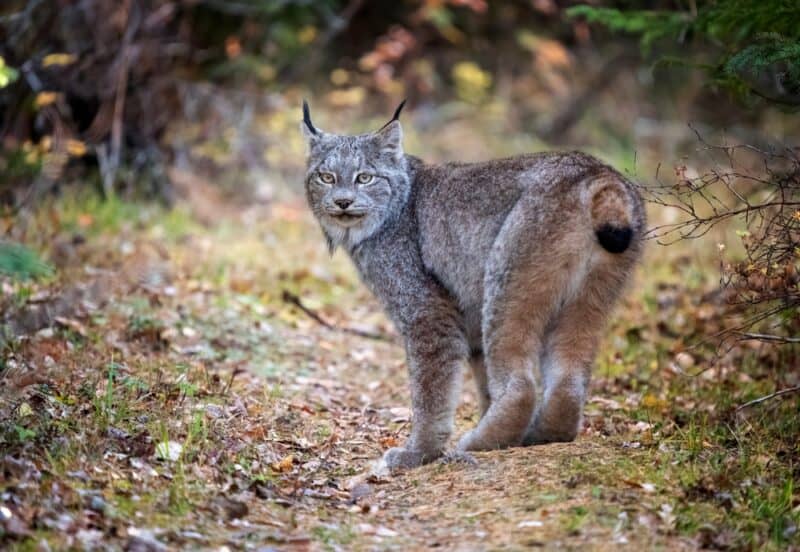
Canada lynx in Idaho (Lynx canadensis)
The Canada Lynx is sometimes also known as the Canadian Lynx. They are medium-sized wild cats that live in the boreal forest in the mountainous areas of Canada and the northern United States. They are 1 of 2 North American members of the “Lynx” genus. The other one is the bobcat.
The majority of the World’s Canada lynx population lives in the boreal forests of Canada and Alaska.
In the United States, there are Canada lynx populations in Alaska. In the contiguous United States, there are lynx in the northern states of Maine, New Hampshire, Vermont, Minnesota, Montana, Idaho, and Washington. There are also lynx in Colorado and possibly northeastern Utah and northern New Mexico.
In the contiguous United States, habitat loss due to human development is the biggest factor that affects Canada lynx populations.
The U.S Fish and Wildlife Service listed the Canada lynx in the contiguous United States as a threatened species under the Endangered Species Act in the year 2,000.
In 2018, the U.S. Fish and Wildlife Service announced that the Canada lynx is under consideration for delisting due to recovery and conservation efforts since the year 2,000. See
Canada lynx have been observed in 32 of Idaho’s 44 counties. See
Canada Lynx Characteristics
What does a Canadian lynx look like? The Canadian Lynx closely resembles its close relative, the bobcat but with some differences. First of all, they are slightly larger than bobcats with longer legs. They are up to 35 1/2 inches (90 cm) long and 26 inches (65 cm) tall. Additionally, they weigh up to 37 and a half pounds (17 kg). While the tail of a bobcat is short or “bobbed,” a lynx’s tail is shorter still.
Lynx don’t have the black bands on the topside of their tails that bobcats have. However, they do have black tips on the ends of their tails. One more difference is that the black tip on a lynx’s tail surrounds the entirety of the tail as if the tail had been dipped in black paint. On the other hand, a bobcat’s black tip is only on the top side of the tail.
Canada Lynx have long, thick grey fur in the winter. By summertime, they have shed their grey fur and have a thinner, shorter reddish brown hair coat instead. Their color is more uniform than that of bobcats. While bobcats have black spots and mottled coloration over their entire body, Lynx are solid tan except for some mottled darker brown spots on their legs.
Canadian Lynx have triangular pointed ears with black backs and long ear tufts of black hair on the tips. The hair tufts are much longer than a bobcat’s. They also have drooping flared facial ruff of white hair on the sides of their face beneath their chin.
Their eyes are green with round black pupils.
Lynx have long legs in proportion to their bodies, with their hind legs being slightly longer than their front ones. This gives their body a peculiar, downhill-sloped appearance.
Canadian Lynx have almost comical-looking oversized furry feet. They put their larger feet to good use. Their large paws function like snowshoes, allowing them to travel and hunt on top of the snow. Canadian lynx feet can keep almost twice as much weight from sinking into the snow as those of a bobcat. This is why they range over the deep snow country of northern Canada while bobcats do not.
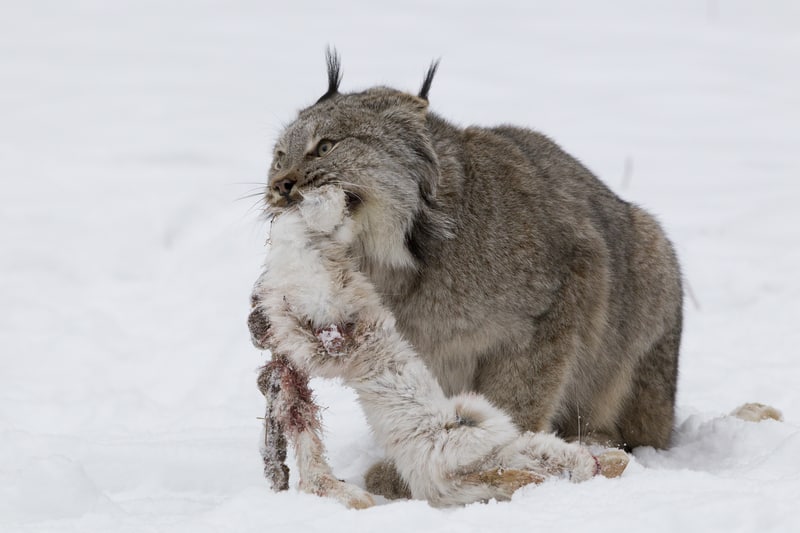
What does Canada Lynx eat?
Mice, squirrels, ptarmigan, grouse, ducks, deer, Dall sheep, and caribou make up a minor portion of a Canadian lynx’s diet in regions where these prey animals are available. However, over most of their range, their preferred food is Snowshoe hares.
Lynx and snowshoe hare
The Canada lynx is very dependent on snowshoe hares for a food source. In some areas, hares comprise 75 percent of their total diet. In fact, their population density is directly correlated with the snowshoe hare population.
Canadian and Alaskan Canadian Lynx and snowshoe hares go through what is known as the Lynx-Snowshoe Hare Cycle. When food sources are abundant for hares, their population increases very rapidly since they can have several litters per year. When hare populations are at their peak, there can be as many as 1500 animals per square kilometer (3913 per square mile). At this time, the population of Lynx and other predators are also at their peaks.
In Idaho, Canada lynx are chiefly dependent on snowshoe hares as prey animals. However, they also feed on deer, squirrels, various other small mammals, birds, and carrion.
Recent Posts
The only venomous snakes in Washington State are Northern Pacific Rattlesnakes. The Northern Pacific Rattlesnake (Crotalus oreganus oreganus) is a sub-species of the Western Rattlesnake. Anyone...
Skunks are not classified as true hibernators. But they go into a state of torpor when the weather gets cold. Skunks are light sleep hibernators, along with opossums, bears, and raccoons. ...

